The Fourth in the Forty-Ninth
Comment via blog
Prev
Next


|
Day 19: July 4, 2016 The Fourth in the Forty-Ninth Comment via blog |
Prev Next |
 
|
|
|
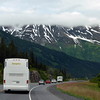
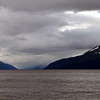 On Independence Day Deb and I again headed south on Seward Highway (AK-1)
but this time we went well beyond Girdwood and Portage and followed the
road to near its end point in the city of Seward. She drove and I snapped
a few pictures including the popular RV driving into a mountain shot. This
time the RV is leading a caravan and the mountain top is hidden by clouds.
On Independence Day Deb and I again headed south on Seward Highway (AK-1)
but this time we went well beyond Girdwood and Portage and followed the
road to near its end point in the city of Seward. She drove and I snapped
a few pictures including the popular RV driving into a mountain shot. This
time the RV is leading a caravan and the mountain top is hidden by clouds.
|
|
|
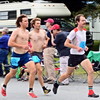
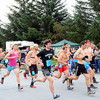
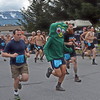
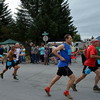
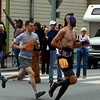
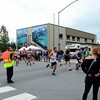 I know this doesn't look anything like caber tossing but that's exactly
what it made me think of. I've always assumed that caber tossing was
started by some slightly inebriated Scotsmen challenging each other to
throwing the heaviest and most unwieldy thing they could locate and this
struck me as something started by a few somewhat impaired Alaskans
deciding to race up and down the highest and steepest thing that they
could find. As it turns out, my thoughts about the beginnings of the
Mount Marathon Race
are not so different from the legend. The legend says that two guys were
talking in a bar when one claimed he could run to and from the top of the
3,022 foot mountain in less than an hour. Eventually someone, not
necessarily the same someone who originally made the boast, tried it and
failed. According to legend, that first attempt took an hour and twenty
minutes which naturally became the time to beat. In 1915 it became an
organized event and runners now routinely finish in well under an hour.
I know this doesn't look anything like caber tossing but that's exactly
what it made me think of. I've always assumed that caber tossing was
started by some slightly inebriated Scotsmen challenging each other to
throwing the heaviest and most unwieldy thing they could locate and this
struck me as something started by a few somewhat impaired Alaskans
deciding to race up and down the highest and steepest thing that they
could find. As it turns out, my thoughts about the beginnings of the
Mount Marathon Race
are not so different from the legend. The legend says that two guys were
talking in a bar when one claimed he could run to and from the top of the
3,022 foot mountain in less than an hour. Eventually someone, not
necessarily the same someone who originally made the boast, tried it and
failed. According to legend, that first attempt took an hour and twenty
minutes which naturally became the time to beat. In 1915 it became an
organized event and runners now routinely finish in well under an hour.
We reached the course just a few blocks from the starting line and a few seconds after the first wave of runners left it. Those runners were soon passing by. And runners continued to pass by for quite some time. The men's and women's events are limited to 400 runners. Runners under 18 have their own event which is limited to 200 entrants. Competitors come from all over the world and it's not just the young and reckless who enter. Men and claymation characters old enough to know better are part of the field. |
|
|
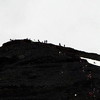
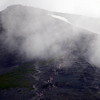
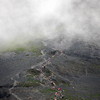
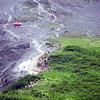
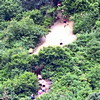
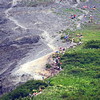 It doesn't take long for runners to begin emerging from the trees on the
lower mountainside and news helicopters move in to capture the action.
Near the top it's clouds rather than trees that hide the runners. The
silhouetted figures atop the mountain are probably all journalists and
officials. The average speed going up is two MPH. Coming down it's twelve.
That's no doubt one of the reasons that it is tougher to spot descending
runners than those still climbing. Even in this
enlargement of a section of the last
photograph everyone appears to be headed upward except the fellow in the
snow patch on the right.
It doesn't take long for runners to begin emerging from the trees on the
lower mountainside and news helicopters move in to capture the action.
Near the top it's clouds rather than trees that hide the runners. The
silhouetted figures atop the mountain are probably all journalists and
officials. The average speed going up is two MPH. Coming down it's twelve.
That's no doubt one of the reasons that it is tougher to spot descending
runners than those still climbing. Even in this
enlargement of a section of the last
photograph everyone appears to be headed upward except the fellow in the
snow patch on the right.
|
|
|
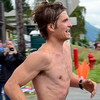
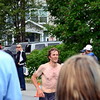
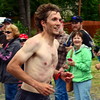 These are the first three runners to pass a point just around the corner
from the finish line and I'm guessing that they finished in this order. I
know for a fact that the fellow in the first picture won. He's David
Norris, a champion skier from Fairbanks who not only won the nearly
vertical race on his first attempt but did it in record time. A record of
43:21 stood from 1981 to 2013 when it was broken by a 42:55 run. That
record was bested just two years later when a Spaniard turned in a 41:48.
Norris brought the title back to Alaska and claimed the record with a time
of 41:26. The race distance is 5 kilometers (3.1 miles) but most of one of
those kilometers is nearly straight up and the next one nearly straight
down.
These are the first three runners to pass a point just around the corner
from the finish line and I'm guessing that they finished in this order. I
know for a fact that the fellow in the first picture won. He's David
Norris, a champion skier from Fairbanks who not only won the nearly
vertical race on his first attempt but did it in record time. A record of
43:21 stood from 1981 to 2013 when it was broken by a 42:55 run. That
record was bested just two years later when a Spaniard turned in a 41:48.
Norris brought the title back to Alaska and claimed the record with a time
of 41:26. The race distance is 5 kilometers (3.1 miles) but most of one of
those kilometers is nearly straight up and the next one nearly straight
down.
|
|
|
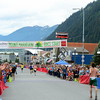
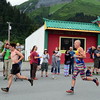
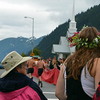
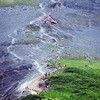 Of course while the leaders were finishing their runs, many others were
still on the mountain and runners would be crossing the finish line for
quite some time.
Of course while the leaders were finishing their runs, many others were
still on the mountain and runners would be crossing the finish line for
quite some time.
|
|
|
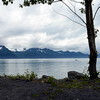
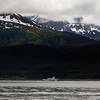 We walked on down to the end of the Seward Highway where I grabbed a
couple pictures of Resurrection Bay.
We walked on down to the end of the Seward Highway where I grabbed a
couple pictures of Resurrection Bay.
|
|
|
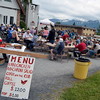
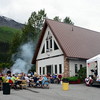 One of the local churches holds a chicken bbq in conjunction with the race
and we indulged. $12 gets you all of this.
One of the local churches holds a chicken bbq in conjunction with the race
and we indulged. $12 gets you all of this.
|
|
|
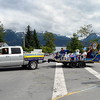
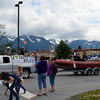 A parade took place while we were eating but, even though we missed it, we
got to see some of the floats as they wound their way through the streets
and we walked to the car.
A parade took place while we were eating but, even though we missed it, we
got to see some of the floats as they wound their way through the streets
and we walked to the car.
And that's the way they celebrate the 4th of July in Seward, Alaska. |
|
|
| [Prev] [Site Home] [Trip Home] [Contact] [Next] |